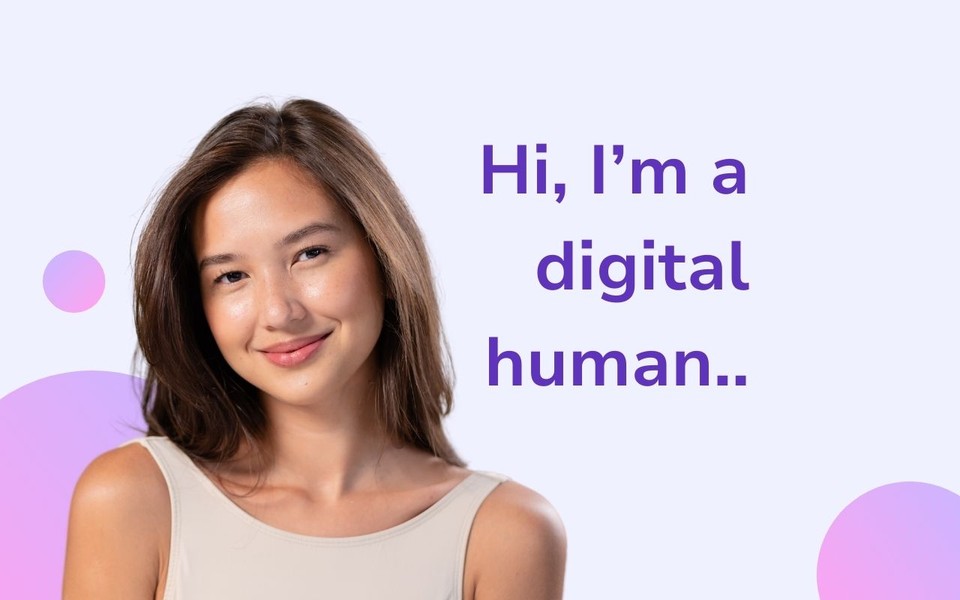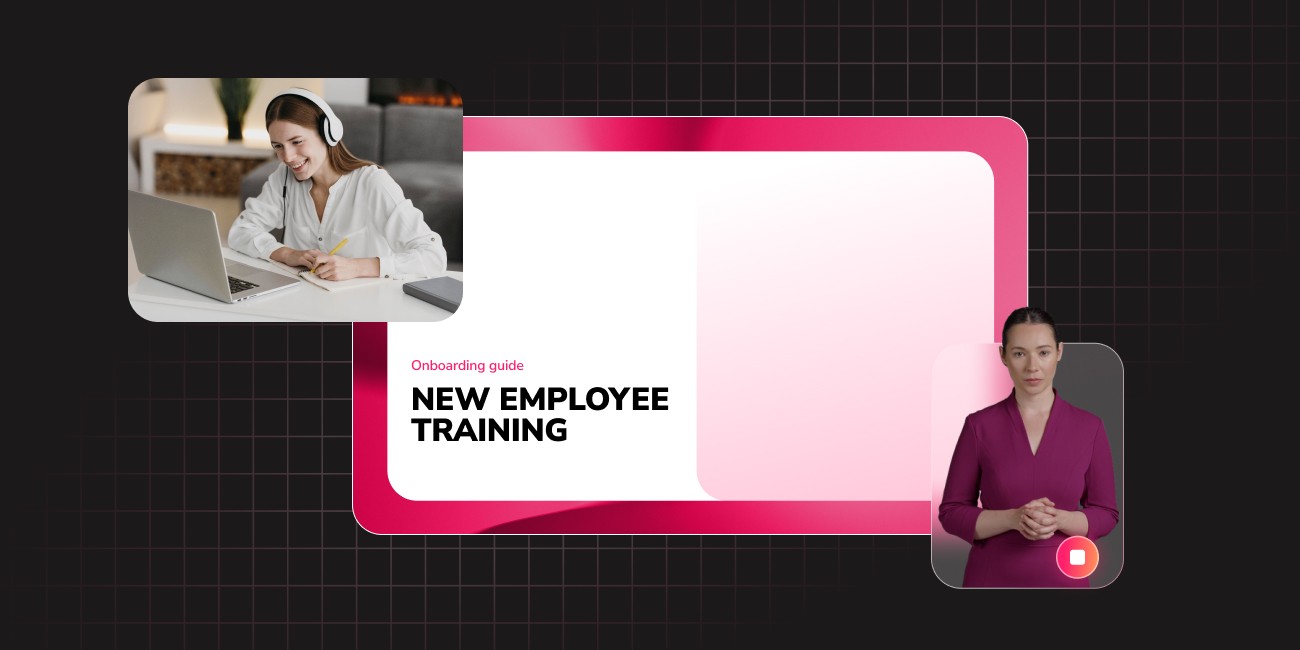Introduction
Imagine sending a training video to your global team and the presenter greets each employee by name, speaks in their native language, and never flubs a line. Sounds like science fiction, right? Except it’s not. That’s the promise of digital humans - AI-powered avatars that can present, explain, and interact like a real person.
But here’s the thing most people skip over: while these virtual presenters can save huge amounts of time and money, they also raise questions about trust, privacy, and even how your brand “feels” to an audience. And those questions aren’t just philosophical - they can make or break adoption.
In this guide, we’ll unpack what digital humans really are, how they’re already reshaping training and internal communication, the ethical tripwires to avoid, and exactly how to pilot one in your own organization without losing that human touch.

What Exactly Are Digital Humans?
A digital human is basically a computer-generated person that looks, sounds, and moves like a real human being - but lives on a screen. Think of it as the sweet spot between a video call and an AI chatbot: it’s got the face, expressions, and voice of a person, but the brains and availability of a machine.
Unlike a cartoon avatar or a simple animated character, digital humans are powered by AI to hold conversations, answer questions, and deliver messages in a way that feels surprisingly natural. Their “personality” comes from a mix of scripts, natural language processing, and sometimes even large language models (LLMs) that make them respond in real time.
How they’re different from avatars, chatbots, and virtual influencers
It’s easy to lump digital humans into the same bucket as other virtual characters, but here’s the breakdown:
-
Avatars → Usually static or game-based characters you control manually. They don’t speak or think on their own.
-
Chatbots → Text-based AI assistants. They can answer you, but you won’t see them smile, pause, or make eye contact.
-
Virtual influencers → Online personas run by a creative team, often pre-scripted and not interactive.
-
Digital humans → Real-time, face-to-face interaction - they listen, process, and respond with both words and expressions.
This difference matters if you’re in training or internal communication - because people pay more attention to something that feels human.
The tech ingredients: AI brains, lifelike faces, natural voices
Behind every convincing digital human, there’s a cocktail of tech:
-
3D modeling to create a realistic head and body
-
Facial animation to sync lips, eyes, and micro-expressions with speech
-
AI speech synthesis for natural, human-like voice output
-
Natural language processing (NLP) to understand and generate conversation
-
Rendering engines (like Unreal Engine’s MetaHuman) for photorealistic skin, hair, and movement
Put all that together, and you’ve got a digital human who can onboard a new employee, guide a learner through a tricky module, or deliver a CEO’s message to every branch - without booking a camera crew or taking up anyone’s calendar.
How Digital Humans Are Made?
The basic recipe: 3D modeling, animation, speech AI, and scripting
Creating a digital human isn’t some mysterious lab experiment - it’s more like building a high-tech puppet that moves and talks on its own.
Here’s the core process, boiled down:
-
Design the look → A 3D model is created using tools like MetaHuman Creator or Blender. This covers skin tone, facial features, hair texture - down to details like freckles or laugh lines.
-
Animate the body → Motion-capture or rigging techniques allow your digital human to blink, tilt their head, and even gesture naturally.
-
Give them a voice → AI speech synthesis turns text into lifelike audio. Modern systems match tone, pace, and even breathing patterns.
-
Teach them to respond → Natural language processing (NLP) enables back-and-forth conversation. This is where chat AI and scripts come together.
-
Render in real time → Game engines like Unreal Engine make them move smoothly on screen, whether in 4K videos or live in a web app.
The big-name tools you might actually use
You don’t need to build everything from scratch. The digital human ecosystem has some serious plug-and-play options:
-
MetaHuman Creator → Unreal Engine’s free tool for hyper-realistic character creation. Great for custom looks.
-
NVIDIA ACE for Digital Humans → A suite of AI microservices (speech recognition, NLP, facial animation) that lets your digital human talk in real time.
-
Fliki → Specializes in animating still images into talking avatars.
-
Soul Machines → Known for emotionally expressive digital humans with personality profiles.
The nice part? Most of these tools have no-code or low-code options. You don’t need to be a 3D artist or machine learning engineer - you just need your content scripts and a clear use case.
How long it really takes to create one
If you’re imagining months of production… relax. A basic scripted digital human for a training module can be made in a day or two with ready-made tools.
-
Simple project (like a welcome video): 1–2 days
-
Moderate (interactive FAQ bot): 1–2 weeks
-
Complex (fully conversational LLM-powered guide): 4–6 weeks
What usually takes the most time? Not the tech - it’s writing the script and deciding how your digital human should behave. The more personality you bake in, the more engaging the end result.
Why They’re More Than a Pretty Face - The Role of Emotion
Emotional recognition and realistic response: why it matters
If you’ve ever had to sit through a monotone training video, you already know - delivery matters.
Digital humans don’t just spit out lines. With emotional recognition tech, they can “read” a user’s tone or facial expression (through a webcam or voice analysis) and adapt their response.
Example: In a sales training simulation, if a learner hesitates or sounds unsure, the digital human might lean in, soften its tone, and offer reassurance - just like a human mentor would. That micro-adjustment keeps the learner engaged and makes the session feel less like talking to a machine.
For internal communication, this can mean a CEO’s message feels more genuine, with pauses, smiles, and vocal inflections that match the mood of the content - whether it’s celebrating a big win or addressing a sensitive issue.
The “uncanny valley” trap - and how new tech is bridging it
We’ve all seen those slightly creepy animations where the eyes don’t quite track right or the smile lingers too long. That’s the uncanny valley - when something looks almost human, but not enough for your brain to relax.
New rendering engines like Unreal Engine 5, paired with AI-driven facial animation (e.g., NVIDIA Audio2Face), are shrinking that valley fast. Micro-expressions, subtle blinks, and even the timing of breaths are now so precise that viewers often forget they’re not looking at a real person after just a few seconds.
Where Digital Humans Shine for Training Managers & Educators
Onboarding that feels personal, even at scale
We all know the onboarding trap: day-one videos that feel like they were filmed in 2005, and a stack of PDFs no one reads.
With digital humans in training and education, you can introduce new hires to company culture through a real-looking guide who knows their name, greets them warmly, and walks them through policies in plain language.
Example: A retail chain used an AI avatar for employee onboarding in multiple countries. The digital human delivered the same consistent message - but in each local language, with culturally relevant gestures and expressions. HR didn’t have to schedule dozens of live sessions, yet new hires reported feeling “welcomed” instead of “processed.”
Soft-skills practice without awkward roleplay
Soft-skills training - think conflict resolution, customer empathy, leadership communication - can be painful to roleplay with colleagues.
Digital humans make it less intimidating. Learners can practice scenarios like handling an upset customer or giving constructive feedback with a responsive AI-powered human who reacts in real time.
The bonus? They can replay the interaction, get AI-driven tips, and try again - without worrying about embarrassing themselves in front of a peer.
Consistent, fatigue-proof delivery for compliance training
Compliance content is often repetitive and high-stakes. Instructors get tired; tone and clarity slip. Digital humans don’t. Checkout the following use-case where a boring presentation is converted into training video with recording anything:
They can deliver the same clear explanation of a safety protocol or data privacy rule at 9 a.m. or 9 p.m., without skipping a detail. And because they look engaged, employees are less likely to mentally check out.
Internal Comms That Don’t Get Ignored
From email fatigue to face-to-face feeling
You’ve probably sent an important company-wide email only to watch engagement sink faster than a Monday morning mood.
Here’s the thing: most employees skim emails - if they open them at all. But swap that text block for a digital human delivering the message, and attention rates climb.
Instead of a static memo, imagine a lifelike avatar of your CEO delivering quarterly results, complete with facial expressions that convey pride or concern. The message feels spoken, not dumped in an inbox.
Global reach, local touch
Internal comms teams often wrestle with language barriers. A digital human can speak 20+ languages while keeping lip-sync and emotional tone intact.
Example: An international manufacturing company used a digital human for safety updates across 15 countries. Employees got the same core message - but in their native language, with cultural nuances intact. Feedback showed employees felt “seen” and “included,” even from headquarters thousands of miles away.
Turning dry policy updates into engaging stories
Let’s be honest: reading about policy changes is about as fun as watching paint dry. But what if those updates were explained by a familiar, friendly digital human who used conversational language and relatable examples?
That’s exactly how a financial services firm increased engagement with compliance updates by 43%. The “face” made the difference - employees remembered the messenger and, by extension, the message.
Extra benefit: availability on-demand
If someone misses the live meeting, the digital human’s message can be replayed any time without losing authenticity. That means your “spokesperson” is available 24/7 - perfect for distributed or shift-based workforces.
How to Pilot a Digital Human in Your Organization (Using Fliki)
Fliki makes experimenting with digital humans surprisingly easy, even for non-tech folks. Here's the simplest way to get started:
-
Subscribe to a Fliki Standard or Premium plan to unlock the AI Avatar feature.
-
Pick your flow:
-
Option A: Use any of the video workflows → hit the avatar icon → pick or preview an avatar → double-click to select.
-
Option B: In the editor, add a layer and choose ‘Avatar’.
-
-
Customize like you own it:
-
Stock avatars, custom image uploads, or generate one from a text prompt.
-
Tweak size, position, animation, transparency, and background.
-
-
Generate: Preview your scene and click “Generate Avatar Video.” Remember- it costs credits per second, so finalize your edits before hitting go.
Why it’s smart for pilots:
-
No need for studio time, camera crews, or advanced editing skills.
-
You can test a single video - like a short onboarding message with real human-like presence.
-
Results are immediate: you can launch, gather feedback, and iterate in minutes, not weeks.
So, if you’re thinking, “I’d love to see how this lands without making a massive commitment,” this route via Fliki gives you a low-risk, high-insight starting point.
The Flip Side - Challenges & Ethical Considerations
Building trust and transparency in digital communication
Digital humans can talk, blink, and look you in the eye but trust doesn’t magically come with pixels. For training managers and communicators, transparency is key. Let your audience know that the friendly face delivering compliance updates or onboarding tips is AI-driven. A quick note - either in the video or in associated materials helps: “This avatar is an AI-powered assistant here to guide you.”
Honesty does wonders. When learners understand that a digital human is an “actor” of sorts, they’re more likely to stay engaged and less likely to feel misled. It’s like meeting someone who’s upfront right from the start - you relaxed, they relaxed, and real connection happens.
Privacy, consent, and representation
Let’s not gloss over the privacy angles. If your digital human adapts- and especially if they can analyze facial expressions or voice tones - you’ve got to ask: Did we get consent? Users should know if and how their reactions are being captured, even if it’s just to improve future interactions.
Representation matters too. A digital human who looks and sounds one way but is made to mimic a diverse workforce risks feeling tone-deaf. Make sure to offer diverse avatar options and voice choices - different genders, skin tones, backgrounds, so no one feels left out or unseen.
Avoiding bias and cultural tone-deafness in AI
Here’s where it gets tricky: the AI models that power digital humans are only as inclusive as the data that trained them. That means unintentional biases - accent preferences, speech patterns, facial expressions - can seep in.
Avoiding that means:
-
Testing avatars on diverse user groups,
-
Checking scripts and tonal delivery for cultural nuance,
-
And staying vigilant about language variants (even within English).
One misstep, like an avatar nodding at the wrong moment can feel awkward or even offensive. So, include multicultural review teams in your pilot to catch blind spots before launching.
Final Thoughts
We’re not far off from digital humans that aren’t just scripted - they chat. Powered by large language models, these avatars can understand unscripted questions and respond on-the-fly. For a training session or internal FAQ corner, that means real-time, context-aware dialogue instead of pre-recorded lines. These systems may even simulate personality traits - quirky humor, empathetic tone - making interactions feel more natural.



